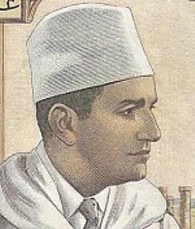MOROCCO
King Mohammed V
1909-1961

Born in 1909 as Sidi Mohammed ibn Yousef, he was part of the Alaouite Dynasty, a line of Moroccan royalty dating back to 1631. This dynasty also claims lineage to the Prophet Mohammed through the prophet’s daughter Fatima Zahra, and Ali ibn Abu Talib the fourth successor to the Prophet Mohammed.
During the French occupation, Mohammed V succeeded his father as Sultan, a title of authority, but less than the title of King. He had been chosen by the French because they thought that he would be more complacent and bend to the French Colonial rulers. However, Mohammed V had became sensitive to the emerging national movement in 1930 after the adoption of the Berber Dahir, a decree of justice that preserved Berber autonomy and isolated them from Islamic law by maintaining their common laws and was in line with the French policies installed in Morocco. This decree wound up causing strife between the Berbers and the Arabs, and in 1934 Mohammed urged the French to abandon the Berber Dahir.
Mohammed V tacitly allowed nationalist demonstrations to take place, carefully maintaining his alliance with the French occupation. Through the Second World War, and the years following, Mohammed V worked to gain more sovereignty from the French and used the Nationalists and their demonstrations to further this movement. He opposed the French in many of their attempts to gain power over the people and in the Vichy attempts during WWII to deport Jews from Morocco to France. In 1942 the Allied forces had taken control of Morocco. In 1943 Roosevelt and Churchill met with Mohammed V at the Casablanca Conference, during which Mohammed V indicated that he would like to pursue an Independent Morocco. Their approval of his pronouncement emboldened Mohammed V in this endeavor.
As the demonstrations against the French occupation became more violent, the French became more frustrated with Mohammed V and exiled him and his family to the island of Corsica (and later to Madagascar) in August 1953, replacing him with Mohammed ibn Aarafa, a distant relative of Mohammed V. The exiled sultan became a symbol of the Nationalists opposition movement by 1955, the French occupation shattered. Aarafa abdicated in 1955 amid protests against his rule. Also faced with rebellion in neighboring Algeria, the French brought Mohammed V back in November 1955 in an effort to help their administration of Morocco, as they saw his changes to be less dramatic than those of the Nationalists.
Once again in power, he was able to maintain the monarchy’s powers while simultaneously allowing the Nationalists gain their own grounds. He was able to broker a deal with the French to gain independence in 1956 upon which he reigned with the full title as King of Morocco. Mohammed V ruled until his death in 1961 upon which his son Hassan II took the throne.
He has been considered for admission to the Righteous Among the Nations, a title recognized by Israel in honoring Non Jewish people who risked their lives to save Jews during the World War II holocaust.
Mohammed V’s portrait was depicted on the 5 and 10 Dirhams banknotes which were issued from 1960 through 1969.

